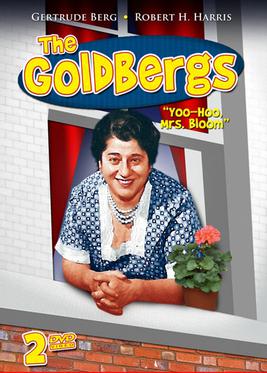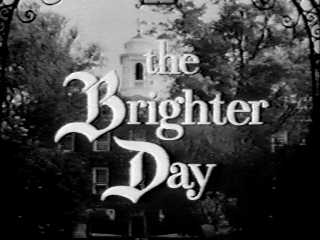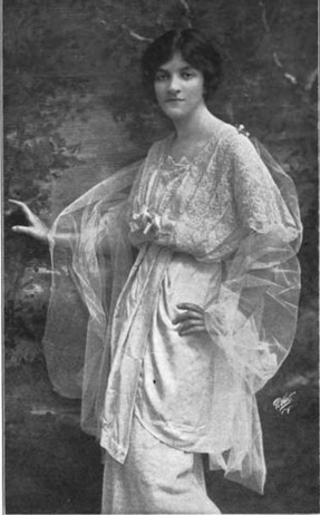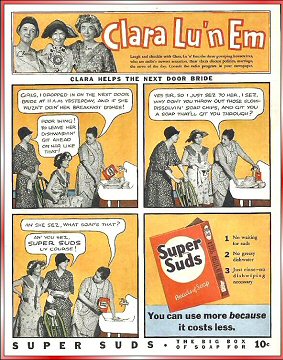Related Research Articles
A soap opera, daytime drama, or soap for short, is typically a long-running radio or television serial, frequently characterized by melodrama, ensemble casts, and sentimentality. The term "soap opera" originated from radio dramas originally being sponsored by soap manufacturers. The term was preceded by "horse opera", a derogatory term for low-budget Westerns.

The Goldbergs is a comedy-drama broadcast from 1929 to 1946 on American radio, and from 1949 to 1956 on American television. It was adapted into a 1948 play, Me and Molly; a 1950 film The Goldbergs, and a 1973 Broadway musical, Molly. It also briefly spun off a comic strip from June 8, 1944, to December 21, 1945, with art by Irwin Hasen, a comic book artist who worked on various DC Comics titles and would later do the Dondi comic strip.

The Young and the Restless is an American television soap opera created by William J. Bell and Lee Phillip Bell for CBS. The show is set in fictional Genoa City. First broadcast on March 26, 1973, The Young and the Restless was originally broadcast as half-hour episodes, five times a week. The show expanded to one-hour episodes on February 4, 1980. In 2006, the series began airing previous episodes weeknights on SOAPnet until 2013, when it moved to TVGN. From July 1, 2013 until 2019, Pop aired previous episodes on weeknights. The series is also syndicated internationally.

Guiding Light is an American radio and television soap opera. Guiding Light aired on CBS for 57 years between June 30, 1952, and September 18, 2009, overlapping a 19-year broadcast on radio between January 25, 1937, and June 29, 1956. With 72 years of radio and television runs, Guiding Light is the longest-running soap opera, ahead of General Hospital, and is the fifth-longest-running program in all of broadcast history; only the American country music radio program Grand Ole Opry, the BBC religious program The Daily Service (1928), the CBS religious program Music and the Spoken Word (1929), and the Norwegian children's radio program Lørdagsbarnetimen (1924–2010) have been on the air longer.

As the World Turns is an American television soap opera that aired on CBS for 54 years from April 2, 1956, to September 17, 2010. Irna Phillips created As the World Turns as a sister show to her other soap opera Guiding Light. With 13,763 hours of cumulative narrative, As the World Turns has the longest total running time of any television show. In terms of continuous run of production, As the World Turns at 54 years holds the fourth-longest run of any daytime network soap opera on American television, surpassed only by General Hospital, Guiding Light, and Days of Our Lives. As the World Turns was produced for its first 43 years in Manhattan and in Brooklyn from 2000 until 2010.

Dynasty is an American prime time television soap opera that aired on ABC from January 12, 1981, to May 11, 1989. The series, created by Richard and Esther Shapiro and produced by Aaron Spelling, revolves around the Carringtons, a wealthy family residing in Denver, Colorado. Dynasty stars John Forsythe as oil magnate Blake Carrington, Linda Evans as his new wife Krystle, and later Joan Collins as his former wife Alexis.

Dr. James Kildare is a fictional American medical doctor, originally created in the 1930s by the author Frederick Schiller Faust under the pen name Max Brand. Shortly after the character's first appearance in a magazine story, Paramount Pictures used the story and character as the basis for the 1937 film Internes Can't Take Money, starring Joel McCrea as Jimmie Kildare. Metro-Goldwyn-Mayer (MGM) subsequently acquired the rights and featured Kildare as the primary character in a series of American theatrical films in the late 1930s and early 1940s. Several of these films were co-written by Faust, who also continued to write magazine stories and novels about the character until the early 1940s. Kildare was portrayed by Lew Ayres in nine MGM films. Later films set in the same hospital featured Dr. Gillespie. Ayres returned to voice the Kildare character in an early 1950s radio series. The 1961–1966 Dr. Kildare television series made a star of Richard Chamberlain and gave birth to a comic book and comic strip based on the show. A short-lived reboot of the TV series, Young Doctor Kildare, debuted in 1972 and ran for 24 episodes.

Lum and Abner was an American network radio comedy program created by Chester Lauck and Norris Goff that was produced from 1931 to 1954. Modeled on life in the small town of Waters, Arkansas, near where Lauck and Goff grew up, the show proved immensely popular. In 1936, Waters changed its name to "Pine Ridge" after the show's fictional town.

Search for Tomorrow is an American television soap opera. It began its run on CBS on September 3, 1951, and concluded on NBC, 35 years later, on December 26, 1986.

The Brighter Day is an American daytime soap opera which aired on CBS from January 4, 1954, to September 28, 1962. Originally created for NBC Radio by Irna Phillips in 1948, the radio and television versions ran simultaneously from 1954–1956. Set in New Hope, Wisconsin, the series revolved around Reverend Richard Dennis and his four children, Althea, Patsy, Babby and Grayling.

One Man's Family is an American radio soap opera, heard for almost three decades, from 1932 to 1959. Created by Carlton E. Morse, it was the longest-running uninterrupted dramatic serial in the history of American radio. Television versions of the series aired in prime time from 1949 to 1952 and in daytime from 1954 to 1955.

Young Doctor Malone is an American soap opera, created by Irna Phillips, which had a long run on radio and television from 1939 to 1963. The producer was Betty Corday (1912–1987), who also produced Pepper Young's Family and later was a co-creator with husband Ted Corday of NBC Daytime's Days of Our Lives.

Elaine Sterne Carrington was an American screenwriter, playwright, novelist and short story author who found her greatest success writing for radio. Carrington originated radio soap opera in 1932, and wrote more than 12,000 daily dramas during her long career. At one time she wrote three separate shows — Pepper Young's Family, When a Girl Marries and Rosemary — that each ran five times a week.

When a Girl Marries is an American daytime radio drama that was broadcast on three major radio networks from 1939 to 1957. Created by Elaine Sterne Carrington, it was the highest rated soap opera during the mid-1940s.

Clara, Lu, 'n Em is a radio soap opera, which first aired on June 16, 1930, over WGN-AM Chicago, Illinois. The show was picked up by the NBC Blue radio network and premiered at 10:30 p.m. Eastern Time on January 27, 1931. Thus, it became the first nationally broadcast radio soap opera. When Clara, Lu 'n Em was moved to a regular daytime time slot on February 15, 1932, it became the first networked daytime soap opera.

John Larkin was an American actor whose nearly 30-year career was capped by his 1950s portrayal of two fictional criminal attorneys – Perry Mason on radio and Mike Karr on television daytime drama The Edge of Night. After having acted in an estimated 7,500 dramatic shows on radio, he devoted his final decade to television and, from April 1962 to January 1965, was a key member of the supporting cast in two prime-time series and made at least twenty major guest-starring appearances in many of the top drama series of the period.
The Best of Everything is an American daytime soap opera which aired on ABC from March 30, 1970, to September 25, 1970. The series was a spin-off of Rona Jaffe's 1958 novel The Best of Everything and the 1959 film of the same name.
Gang Busters is an American dramatic radio program heralded as "the only national program that brings you authentic police case histories." It premiered on January 15, 1936, and was broadcast over 21 years through November 27, 1957.

Days of Our Lives is an American television soap opera that streams on the streaming service Peacock. The soap, which aired on the American television network NBC from 1965 to 2022, is one of the longest-running scripted television programs in the world, airing nearly every weekday since November 8, 1965. A co-production of Corday Productions and Sony Pictures Television, the series was created by husband-and-wife team Ted Corday and Betty Corday. During Days of Our Lives' early years, Irna Phillips served as a story editor for the program and many of the show's earliest storylines were written by William J. Bell, who would depart the series in 1975 to focus full-time on The Young and the Restless, which he created for CBS in 1973. Following the 2007 cancellation of Passions, Days of Our Lives remained the only soap opera airing on NBC. On August 3, 2022, NBCUniversal announced that it would relocate the series exclusively to its Peacock streaming service beginning September 12 after 57 years on the network and leaving NBC as the only Big Three network without a daytime serial.
Kitty Foyle is an American old-time radio and television soap opera originally aired during the 1940s and 1950s that was based on the 1940 film of the same name starring Ginger Rogers. Kitty Foyle was created by soap opera mogul Irna Phillips of Guiding Light fame and produced by daytime radio monarchs Frank and Anne Hummert of Helen Trent recognition. The program originally starred Julie Stevens in the title role of Kitty Foyle on radio. On television, the title role was portrayed by Kathleen Murray.
References
- ↑ "What Do You Want To Know?" (PDF). Radio and Television Mirror. 14 (5): 63. September 1940. Retrieved 9 March 2015.
- ↑ Inc, Nielsen Business Media (Jan 25, 1964). "Billboard". Nielsen Business Media, Inc. Retrieved Apr 28, 2019– via Google Books.
{{cite web}}:|last=has generic name (help) - ↑ McHatton, Martha (May 10, 1948). "Indianapolis on the Air". The Indianapolis News. p. 25. Retrieved February 9, 2024– via Newspapers.com.
- ↑ "Potrzebie" . Retrieved Apr 28, 2019.